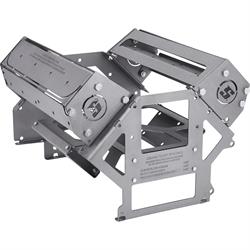Pick a Side: LS Engines
We’re getting ready to pack our bags and head to LS Fest in a few weeks. We always love hitting this show to see the crazy things that folks are doing with GM’s Gen III, IV, and V engines. But it also reminds us that man, LS engines are everywhere. They’re the new small block Chevy; you almost expect to see them under the hood of every car at the car show. And for good reason. They can make stupid power with little more than a cam swap. Add turbos and things can get really hairy. Bottom line, they're popular because they work. But is that enough to make you want to jump on the bandwagon, or does it make you want to swim against the current with an unexpected powerplant?
Let’s start this conversation off with a little personal narrative. I’m in the process of digging my first car out of long term storage. It’s an ’86 Buick Regal and I love it every bit as much now as I did when I was 16. So, of course I’ve been laying awake at night dreaming about what to do to it now that my skill and finances match what I wished they were as a teenager. One of the first things on the list is an engine swap. The trusty old Olds 307 still runs ok, but boy is it slow. It’s out of breath by 4000 rpm and it takes forever to get there thanks to the absurd 2.40-something rear gear. It’s gotta go. But, what to replace it with? The answer that everyone gives me when I ask for advice is that I should LS swap it. Even better, a turbo LS to make it a turbo Regal of a different color. But you know what? I don’t know if I can bring myself to do it. It's just so predictable, but it's hard to argue with cheap horsepower...
Since the birth of hot rodding, there have been a handful of go-to engines for those wanting to go fast. First was the flathead Ford V8. Our whole industry sprung up around the venerable flatty and they were everywhere. Then, in the 50’s, the new overheads took over. Flatmotors were being yanked left and right in favor of the easy power that came from Olds Rockets, Hemis, and yes, eventually, the small block Chevy. By the time I entered the scene in the 80’s, Chevy’s Mouse motor had been swapped into just about everything. By the late 90’s, the good old small block was already more than 40-year-old technology, and those of us holding on to them were getting stomped by new Camaros, Firebirds, and Corvettes with an all-aluminum mystery motor. Welcome to the LS era. We’re 25 years in and it shows no sign of slowing down. The same aftermarket that built itself around the flathead and Gen I and II small block Chevy has embraced the LS. As a point of refence, you can check out the huge selection of LS go fast goodies in the Speedway Motors catalog.
While we’re looking back at hot rod history, let’s also remember the proud tradition of doing something unexpected under the hood. We went deep on this in our Engine Swaps article a while back. It’s always been fun to pull up to the cruise night with a hot engine loping and rumbling, then pop the hood and watch the crowd gather when it’s something completely outrageous. Back in the day this might have been a ’40 Ford with a 390 Cad or a ’34 3-window with a Wayne headed Jimmy 6. Recently, I’ve watched this happen with a Hellcat swapped squarebody truck, a supercharged and turbo’d V6 Grand Prix, and a Ford Coyote in a Fox-Body Cobra.
So, what’s more important? Cheap LS power with a whole bunch of aftermarket support or the adrenaline rush when you open the hood on a Frankenstein creation that nobody saw coming? As for me and that Regal, I’m still on the fence. I’ve already picked out all the pieces on the Speedway website to plop in a junkyard 5.3 and maybe even hang a turbo on it. But then I’ll have a crazy dream and start looking for junkyard 392 Hemis and Ford Coyotes. I’ll let you know where I end up.
But for now, we want to know where you stand. Are you ready to LS swap the world, or are you tired of them and ready for something completely different? Let us know what you think on our Facebook and Instagram pages.



